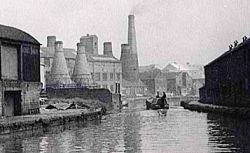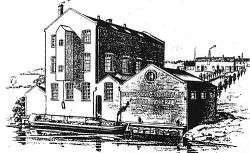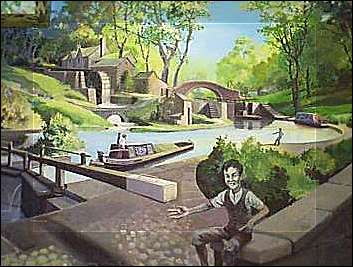Waterways of Stoke-on-Trent
![]()
Stoke-on-Trent Canals and Waterways
|
In the frantic rush to build canals to feed the Industrial Revolution, Staffordshire was at the heart of the action. There are more miles of canals within its boundaries than any other county in England. At the centre of this county revolution was the Stoke-on-Trent pottery industry, for which a navigable system of transport was to bring huge benefits. The foremost thinker was Josiah Wedgwood who commissioned the local engineer James Brindley to create the Trent and Mersey Canal which enabled kaolin (china clay) to be brought from Cornwall right to the door of his Etruria factory. Equally important, the finished products could be taken away smoothly, with the minimum of breakages. |
 Trent & Mersey Canal |
 Caldon Canal |
 Burslem Branch Canal |
 Newcastle Canals |
|
The Trent and Mersey Canal, completed in 1777, connects the River Trent at Derwent Mouth to the River Mersey at Runcorn. Engineered by James Brindley, it spans about 93 miles and was vital for transporting pottery, coal, and goods during the Industrial Revolution, linking major industrial regions of England. |
The Caldon Canal, completed in 1779, branches from the Trent and Mersey Canal at Etruria in Stoke-on-Trent. Built to transport limestone and other goods, it runs about 18 miles to Froghall. |
The Burslem Branch Canal, opened in 1805, was a short arm of the Trent and Mersey Canal serving Burslem in Stoke-on-Trent. Built to transport pottery and raw materials, it fell into disuse after breaches in 1961. Restoration efforts aim to revive it as part of local heritage regeneration. |
Newcastle-under-Lyme was once served by three canals: Sir Nigel Gresley's canal, Newcastle to Stoke canal, Newcastle Junction canal. Built in the late 18th and early 19th centuries, they connected local collieries and industries to the Trent and Mersey Canal, transporting coal, iron, and pottery. By the mid-20th century, all three were closed and largely filled in or lost. |
| | | |
River Trent | Fowlea Brook | Lyme Brook

A compilation of locks and mills around Stoke-on-Trent
from the mural in The
Potteries shopping centre, Hanley
Trent & Mersey Canal | Burslem Branch Canal | Cauldon Canal | Newcastle Canal |
River Trent | Fowlea Brook | Lyme Brook
Map of the rivers and brooks of Stoke-on-Trent
The Trent & Mersey and Cauldon canals both pass through Stoke-on-Trent
The Trent and Mersey Canal
links the River Trent near Derby with the Mersey at Runcorn. The Harecastle Tunnel at Kidsgrove is an amazing feat of engineering in the form of a tiny narrow hole through a hillside. In the first tunnel, 2880 yards long and built in 1766-77, barges had to be 'legged' through the tunnel by men lying on their backs and pushing against the roof with their feet to give the boat momentum. Thomas Telford modernised the tunnel in 1827 by building a new wider tunnel alongside it, complete with a towpath. Telford's tunnel is still used by pleasure boats, as is the whole canal. An attractive feature of the canal at Etruria is the marina, a popular mooring place for pleasure craft, with the China Gardens pub alongside.
The Caldon Canal
joins the Trent and Mersey at Etruria, Stoke-on-Trent, and was built to carry minerals from the uplands of the Peak District to the Potteries. In recent years, the canal has been restored for pleasure craft, a magnificent section being through the Churnet Valley. Reminders of the Industrial Revolution along its banks include the remains of lime kilns, ironstone workings and ironworks. Perhaps the best is the Flint Mill at Cheddleton, now restored as a museum of industrial archaeology. A popular feature is horse-drawn boat trips along the canal, run from the restored canalside warehouse at Froghall Wharf.
questions/comments/contributions? email: Steve Birks